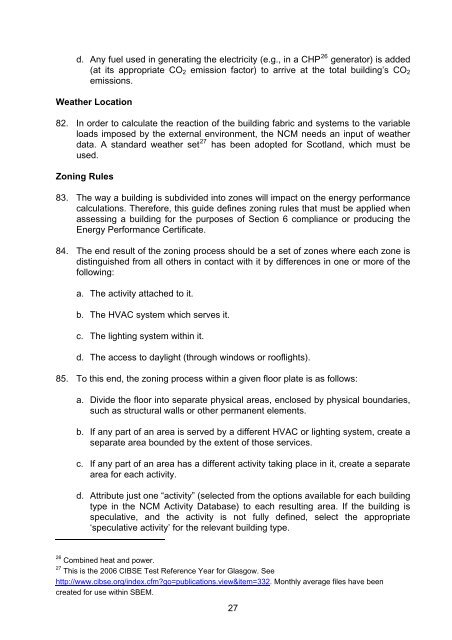National Calculation Methodology (NCM) - Scottish Government
National Calculation Methodology (NCM) - Scottish Government
National Calculation Methodology (NCM) - Scottish Government
Create successful ePaper yourself
Turn your PDF publications into a flip-book with our unique Google optimized e-Paper software.
d. Any fuel used in generating the electricity (e.g., in a CHP 26 generator) is added<br />
(at its appropriate CO2 emission factor) to arrive at the total building’s CO2<br />
emissions.<br />
Weather Location<br />
82. In order to calculate the reaction of the building fabric and systems to the variable<br />
loads imposed by the external environment, the <strong>NCM</strong> needs an input of weather<br />
data. A standard weather set 27 has been adopted for Scotland, which must be<br />
used.<br />
Zoning Rules<br />
83. The way a building is subdivided into zones will impact on the energy performance<br />
calculations. Therefore, this guide defines zoning rules that must be applied when<br />
assessing a building for the purposes of Section 6 compliance or producing the<br />
Energy Performance Certificate.<br />
84. The end result of the zoning process should be a set of zones where each zone is<br />
distinguished from all others in contact with it by differences in one or more of the<br />
following:<br />
a. The activity attached to it.<br />
b. The HVAC system which serves it.<br />
c. The lighting system within it.<br />
d. The access to daylight (through windows or rooflights).<br />
85. To this end, the zoning process within a given floor plate is as follows:<br />
a. Divide the floor into separate physical areas, enclosed by physical boundaries,<br />
such as structural walls or other permanent elements.<br />
b. If any part of an area is served by a different HVAC or lighting system, create a<br />
separate area bounded by the extent of those services.<br />
c. If any part of an area has a different activity taking place in it, create a separate<br />
area for each activity.<br />
d. Attribute just one “activity” (selected from the options available for each building<br />
type in the <strong>NCM</strong> Activity Database) to each resulting area. If the building is<br />
speculative, and the activity is not fully defined, select the appropriate<br />
‘speculative activity’ for the relevant building type.<br />
26 Combined heat and power.<br />
27 This is the 2006 CIBSE Test Reference Year for Glasgow. See<br />
http://www.cibse.org/index.cfm?go=publications.view&item=332. Monthly average files have been<br />
created for use within SBEM.<br />
27

















